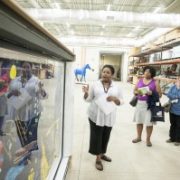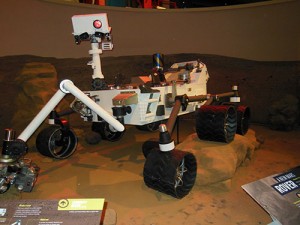Even though the weather is turning chilly, Affiliates are keeping things hot with events from coast to coast.
CALIFORNIA
General John Dailey, Director of the National Air and Space Museum, will be inducted into the International Air and Space Hall of Fame at the San Diego Air and Space Museum, 11.1.

Environmental pins on loan from the Smithsonian to an Affiliate in California
The Sonoma County Museum will present Hole in the Head: The Battle for Bodega Bay and the Birth of the Environmental Movement exhibition, featuring 13 protest buttons on loan from the National Museum of American History, in Santa Rosa, 11.2.
DISTRICT OF COLUMBIA
The National Inventors Hall of Fame will participate in the Smithsonian Innovation Festival in Washington, 11.1-2.
Organized by the High Museum of Art in Atlanta, an exhibition titled Rising Up: Hale Woodruff’s Murals at Talladega College opens at the Smithsonian, presented by the National Museum of African American History and Culture in their gallery at the National Museum of American History in Washington, 11.7.
PENNSYLVANIA
The Heinz History Center presents jazz innovation as part of its Places of Invention ongoing project with the Smithsonian’s Lemelson Center, in Pittsburgh, 11.1.
NEBRASKA
Undersecretary Richard Kurin presents a talk and booksigning on The Smithsonian’s History of America in 101 Objects at the Durham Museum in Omaha, 11.4.

Earth from Space exhibition in New Mexico
NEW MEXICO
Dr. Andrew Johnston, geographer and curator at the National Air and Space Museum, presents a public talk at the New Mexico Museum of Space History in Alamogordo, 11.6.
VIRGINIA
George Washington’s Mount Vernon Estate and Gardens presents The Face of the Nation: George Washington, Art, and America symposium, featuring National Portrait Gallery curator Wendy Wick Reaves and curator emerita Ellen Miles, at Mount Vernon, 11.7.
GEORGIA
National Portrait Gallery researcher and author Warren Perry presents a public lecture on Guns, Horses, Uniforms, and More Guns: Themes of American Civil War Visual Culture at the Morris Museum of Art in Augusta, 11.13.
Jeff Post, Curator at the National Museum of Natural History will present a public lecture on the Hope Diamond at the Tellus Science Museum in Cartersville, 11.21.
PUERTO RICO
Affiliations Director Harold Closter leads a workshop on Designing Museum Budgets at the Museo y Centro de Estudios HumanÃsticos in Gurabo, 11.15.

25 Smithsonian artifacts from the film industry will be on view soon in North Carolina
NORTH CAROLINA
The North Carolina Museum of History will present Starring North Carolina! an exhibition of the state’s role in the film industry featuring 25 artifacts on loan from the National Museum of American History, in Raleigh, 11.15.
LOUISIANA
Undersecretary Richard Kurin presents a talk and booksigning on The Smithsonian’s History of America in 101 Objects at the National World War II Museum in New Orleans, 11.18.





























